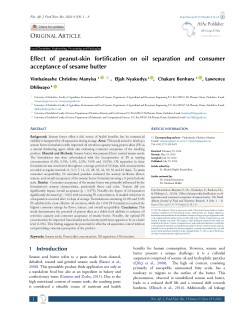Main Article Content
Effect of peanut-skin fortification on oil separation and consumer acceptance of sesame butter
Abstract
Background: Sesame butter offers a rich source of health benefits, but its commercial viability is hampered by oil separation during storage.
Aims: This study aimed to develop a sesame butter formulation with improved oil retention capacity using peanut skins (PS) as a natural thickening agent, while also evaluating consumer acceptance of the resulting product.
Material and Methods: Sesame butter was prepared from roasted sesame seeds. The formulation was then reformulated with the incorporation of PS at varying concentrations (0.0%, 0.5%, 1.0%, 2.0%, 5.0% and 10.0%). Oil separation in these formulations was monitored throughout a storage period of 63 days, with measurements recorded at regular intervals (1, 3, 5, 7, 14, 21, 28, 35, 42, 49, 56 and 63 days). To assess consumer acceptability, 50 untrained panelists evaluated the sensory attributes (flavor, texture, and overall acceptance) of the sesame butter formulations using a 9-point hedonic scale.
Results: Consumer acceptance of the sesame butter was primarily influenced by the formulation's sensory characteristics, particularly flavor and color. Texture did not significantly impact overall acceptance (p = 0.975). Notably, the degree of oil separation significantly decreased (p = 0.00) with increasing PS concentration. A marked reduction in oil separation occurred after 14 days of storage. Formulations containing 10.0% and 5.0% PS exhibited the most effective oil retention, while the 1.0% PS formulation received the highest consumer ratings for flavor, texture, and overall acceptability.
Conclusion: This study demonstrates the potential of peanut skins as a viable food additive to enhance oil retention capacity and consumer acceptance of sesame butter. Notably, the optimal PS concentration for improved functionality and consumer preference appears to be at a lower level (1.0%). This finding suggests the potential for effective oil separation control without compromising consumer perception of the product.







